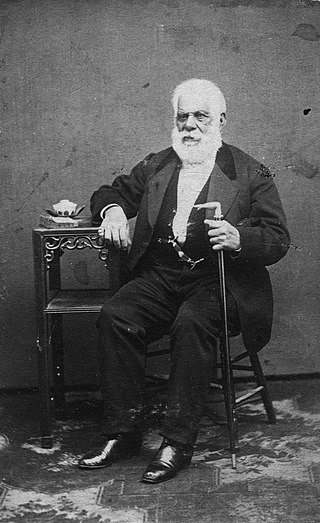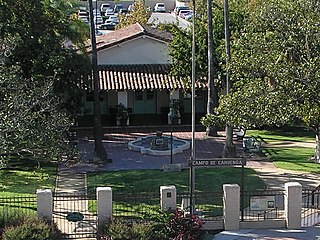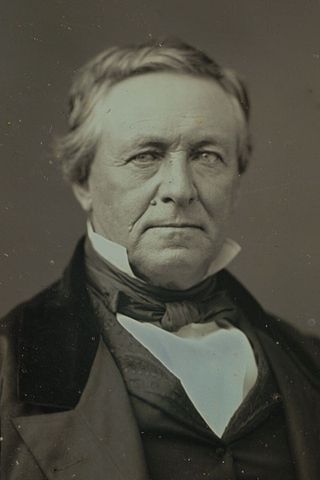
John Augustus Sutter, born Johann August Sutter and known in Spanish as Don Juan Sutter, was a Swiss immigrant who became a Mexican and later an American citizen, known for establishing Sutter's Fort in the area that would eventually become Sacramento, California, the state's capital. Although he became famous following the discovery of gold by his employee James W. Marshall and the mill-making team at Sutter's Mill, Sutter saw his own business ventures fail during the California Gold Rush. Those of his elder son, John Augustus Sutter Jr., were more successful.

The Treaty of Cahuenga, also called the Capitulation of Cahuenga, was an 1847 agreement that ended the Conquest of California, resulting in a ceasefire between Californios and Americans. The treaty was signed at the Campo de Cahuenga on 13 January 1847, ending the fighting of the Mexican–American War within Alta California. The treaty was drafted in both English and Spanish by José Antonio Carrillo and signed by John C. Frémont, representing the American forces, and Andrés Pico, representing the Mexican forces.

The Battle of Monterey, at Monterey, California, occurred on 7 July 1846, during the Mexican–American War. The United States captured the town unopposed.

The California Republic, or Bear Flag Republic, was an unrecognized breakaway state from Mexico, that for 25 days in 1846 militarily controlled an area north of San Francisco, in and around what is now Sonoma County in California.

Don Pío de Jesús Pico IV was a Californio politician, ranchero, and entrepreneur, famous for serving as the last governor of Alta California under Mexican rule from 1845 to 1846. He briefly held the governorship during a disputed period in 1832. A member of the prominent Pico family of California, he was one of the wealthiest men in California at the time and a hugely influential figure in Californian society, continuing as a citizen of the nascent U.S. state of California.

John Bidwell, known in Spanish as Don Juan Bidwell, was an American pioneer, politician, and soldier. Bidwell is known as the founder of the city of Chico, California.
New Helvetia, meaning "New Switzerland", was a 19th-century Alta California settlement and rancho, centered in present-day Sacramento, California.

Californios are Hispanic Californians, especially those descended from Spanish and Mexican settlers of the 17th through 19th centuries before California was annexed by the United States. California's Spanish-speaking community has resided there since 1683 and is made up of varying Spanish and Mexican origins, including criollos, Mestizos, Indigenous Californian peoples, and small numbers of Mulatos. Alongside the Tejanos of Texas and Neomexicanos of New Mexico and Colorado, Californios are part of the larger Spanish-American/Mexican-American/Hispano community of the United States, which has inhabited the American Southwest and the West Coast since the 16th century. Some may also identify as Chicanos, a term that came about in the 1960s.

Nancy Kelsey was a member of the Bartleson–Bidwell Party. She was the first white woman to travel overland from Missouri, seeing Utah and Nevada before crossing the Sierra Nevada mountains into California on November 25, 1841. Wife of Benjamin Kelsey, and the mother of eight surviving children, she is sometimes referred to as the "Betsy Ross of California" for her role in creation of the original Bear Flag from which Bear Flag Rebellion got its name.

Andrés Pico was a Californio who became a successful rancher, fought in the contested Battle of San Pascual during the Mexican–American War, and negotiated promises of post-war protections for Californios in the 1847 Treaty of Cahuenga. After California became one of the United States, Pico was elected to the state Assembly and Senate. He was appointed as the commanding brigadier general of the state militia during the U.S. Civil War.

Juan Bautista Valentín Alvarado y Vallejo usually known as Juan Bautista Alvarado, was a Californio politician that served as Governor of Alta California from 1837 to 1842. Prior to his term as governor, Alvarado briefly led a movement for independence of Alta California from 1836 to 1837, in which he successfully deposed interim governor Nicolás Gutiérrez, declared independence, and created a new flag and constitution, before negotiating an agreement with the Mexican government resulting in his recognition as governor and the end of the independence movement.

The Campo de Cahuenga, near the historic Cahuenga Pass in present-day Studio City, California, was an adobe ranch house on the Rancho Cahuenga where the Treaty of Cahuenga was signed between Lieutenant Colonel John C. Frémont and General Andrés Pico in 1847, ending hostilities in California between Mexico and the United States. The subsequent Treaty of Guadalupe Hidalgo of 1848, ceding California, parts of Colorado, Nevada, New Mexico, and Arizona to the United States, formally ended the Mexican–American War. From 1858 to 1861 the Campo de Cahuenga became a Butterfield Stage Station.

Joseph Manuel María Joaquin Micheltorena y Llano was a brigadier general and adjutant-general of the Mexican Army, Governor of California, commandant-general and inspector of the department of Las Californias, then within Mexico. Micheltorena was the last non-Californian born Mexican governor, preceding the San Gabriel-born Pío Pico, the last provincial governor.

John Marsh, later known in Spanish as Don Juan Marsh, was a physician, ranchero, and linguist in California when it was still part of the Republic of Mexico. Born in Massachusetts, Marsh immigrated to California in 1836, where he became a Mexican citizen. He was baptized as Roman Catholic in order to buy land, and acquired the vast land grant of Rancho Los Méganos in Contra Costa. He became one of the wealthiest ranchers in California, and was among the highly influential men who worked to gain United States statehood after Mexico ceded this area following its defeat in the Mexican-American War.
Manuel Victoria was governor of the Mexican-ruled territory of Alta California from January 1831 to December 6, 1831. He died in exile. He was appointed governor on March 8, 1830 by Lucas Alamán.
In 1841, the Bartleson–Bidwell Party, led by Captain John Bartleson and John Bidwell, became the first American emigrants to attempt a wagon crossing from Missouri to California.
The history of the San Fernando Valley from its exploration by the 1769 Portola expedition to the annexation of much of it by the City of Los Angeles in 1915 is a story of booms and busts, as cattle ranching, sheep ranching, large-scale wheat farming, and fruit orchards flourished and faded. Throughout its history, settlement in the San Fernando Valley was shaped by availability of reliable water supplies and by proximity to the major transportation routes through the surrounding mountains.

The Conquest of California, also known as the Conquest of Alta California or the California Campaign, was an important military campaign of the Mexican–American War carried out by the United States in Alta California, then a part of Mexico. The conquest lasted from 1846 into 1847, until military leaders from both the Californios and Americans signed the Treaty of Cahuenga, which ended the conflict in California.

Marsh Creek State Historic Park is a California state park in east Contra Costa County, California, United States. It was named as the newest California State Park on January 27, 2012. The newly named park contains 3,659 acres and is about 3.3 miles (5.3 km) south of downtown Brentwood.

The Camron-Stanford House is the last of the 19th-century Victorian mansions that once surrounded Lake Merritt in Oakland, California. It was the home to a series of influential families, and in 1907, became the city's first museum.

















